Physical fitness and leadership are interconnected in more ways than can be written. On paper, leadership accounts for 50% of candidates’ overall grade while physical fitness makes up 25%. The reality is that the two categories of evaluation and not separable. Physical fitness will play an important role when it comes to proving your leadership ability.
It should come as no surprise that Officer Candidates School tests for leadership competency in the midst of stressful and physically intense environments. Maintaining authority and control when the platoon is sitting on their camp stools eating MRE’s is one thing, but doing so during a 12 mile hike is another story. Candidates will be tested under strenuous circumstances and those who are not prepared physically will have a difficult time commanding their platoons.
Officers Lead From The Front … Literally
As the saying goes, “Officers lead from the front.”
This may not always mean running straight into the battlefield charging your Marines forward, but it does require that you be capable of doing so if the situation ever did arise. At OCS, there are detailed formation guidelines for training evolutions. These formations stem from the way training is conducted out in the real Marine Corps.
Billet holders will be required to maintain a certain position in formation throughout various platoon activities. Failing to do your duty as a billet holder is a red flag that tells the instructors you don’t have what it takes.
Those without billets shouldn’t start relaxing. There may not be as much pressure to perform well, but the instructors are still watching you.
Conditioning March
There are going to be several hikes throughout Marine OCS. Some will be short movements to get the platoon from one place to another. These are usually 3-6 miles and done at a fairly high pace. The most important of these will be the 15-km(9.3 mile) conditioning march which is a graduation requirement. Failing the 9 mile means that you fail OCS. Candidates may have the opportunity to make-up the failure with the 12 mile march, but don’t count on it.
How does leadership factor in?
It is quite simple really. Everyone with a billet is going to be expected to carry out the tasks they are responsible for. If you aren’t fit enough to keep up with the conditioning march, how can you expect to do your duty effectively. Here are some examples for billet holders.
The Candidate Platoon Commander is always in front of the platoon. If he/she can’t keep up and falls back the entire platoon is going to be watching. There is no easier way to lose the confidence and respect of your peers. It doesn’t matter if you are tired, hungry, or have blisters. The Candidate Platoon Commander must remain calm and confident throughout the hikes and not show any weakness as a leader. During rest periods, the Candidate PltCdr should be talking with individuals and reporting to the Staff PltCdr the condition of the platoon.
The Candidate Platoon Sergeant has an even tougher job. That candidate has to manage and take care of everyone in the platoon. This means running up and down the formation checking on individuals, giving reports to the Candidate Platoon Commander and Staff Platoon Sergeant, taking charge during rest periods, getting water refills to everyone, etc. If the Candidate PltSgt can barely keep up with the hike there is no way they will be able to execute the tasks expected of them. Incredibly physically fit individuals can still struggle with this.
Platoon Runs
Platoon runs are another opportunity for candidates to embarrass themselves. One of the first PT sessions candidates undergo is the introductory run which is basically a run throughout the Quantico hills that shows you where everything is. It is not a graded event, but the staff will often record the names of candidates who fall out. You might as well put a target on your back for the staff to aim at.
The responsibilities of billet holders is similar to that of the hikes. The main difference is going to be the added chaos from the increased pace. For example, the Candidate Platoon Sergeant now has to sprint from the rear of the platoon to the front in order to report issues.
The Weak Will Be Chosen
The staff at OCS is aware of just about everything and everyone in platoon. They absolutely do take into account upcoming events when choosing billet holders. If you have show yourself to be a slow runner, don’t be surprised when you end up the Candidate PltSgt for the Endurance Course introduction run done as a platoon.
The purpose of OCS is to evaluate candidates. The staff wouldn’t be doing the Marines justice if they didn’t test candidates where it hurt most.
Be Ready Physically
The PFT and CFT do have their merits when it comes to showing that you are fit enough to lead Marines. However, physical events that are done as a platoon, or in a squad/fire team, carry significantly more weight when it comes to proving leadership ability. A candidate who runs a 22 minute 3 mile is still going to have to keep up with the Staff Platoon Commander who chooses to run the platoon at an 18 minute 3 mile pace.
Minimum Suggested Physical Benchmarks For Platoon Activities
- 3 mile run – 21 min males / 24 min females
- 3 mile run in boots – 24 min / 27 min females
- 5 mile run – 40 min males / 50 min females (actual expected scores for a 5 mile run event)
- Hike 12 miles with 60-100 lbs of gear (males and females)
Don’t get comfortable because you can pass the PFT. Make sure you train your feet for hiking long distances, continue to improve running speed, and push yourself to new limits. The staff at OCS expect it. The candidates standing beside you expect it. Most importantly, the Marines you are aspiring to lead expect it.
There is no single workout that can prepare you for OCS. Continue to train using the resources provided here and through your OSO/NROTC unit.

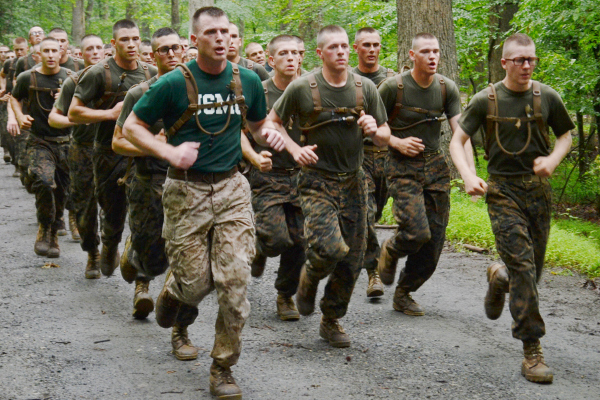


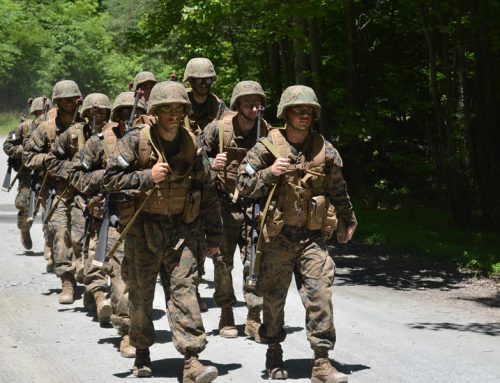
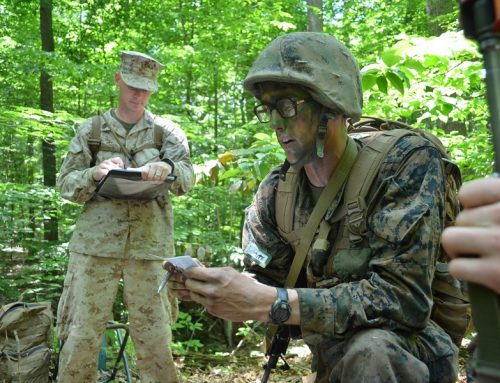
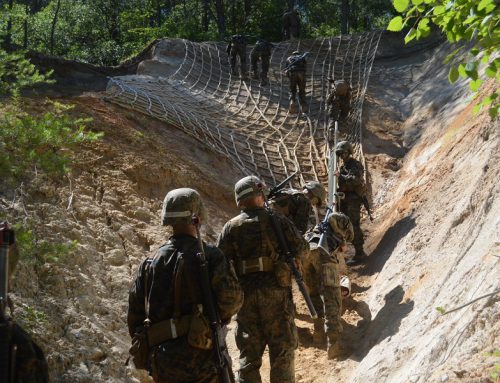
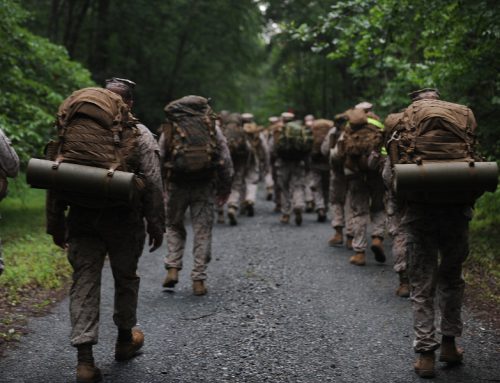
Thank you sir for another great read.
I am continually checking your blog everyday.
Sorry for the double post sir, but do you remember the candidate average 3 mile time was?
Will,
Don’t hesitate to ask questions. It is rewarding for me to get interaction and actually know that someone is reading this stuff. There is a huge spectrum of run times at OCS. The fastest in my company was around 16 minutes, and I don’t recall anyone failing past 24 minutes. The average was probably around 19:30. Keep in mind that this was for the 6-week bulldog program (NROTC) I attended. The other programs could vary significantly.
Semper Fi
Good evening Sir, thank you for this blog I’ve found it extremely helpful/informative in regards to OCS preparation. The question I have is concerning the hikes. For the hikes what is the average pace of the platoon? Roughly 3-4 mph? And you mentioned the requirement of the completion of the 9 mile hike to graduate, does this mean a candidate just needs to complete the hike in general or do candidates get a specific time constraint? Thank you again for your time and help Sir.
Ben
Great questions Ben. You will never go faster than 3.5 mph for the hikes, and the average pace will probably be around 3 mph. There is a 10 minute break every 3 miles as well. Interestingly, the average speed is going to vary based on which increment of OCS you attend. The reality is that increments with female candidates will probably have a slightly slower pace. There are no time constraints for the hike. All candidates have to do is finish. More specifically, a candidate will FAIL the hike if they fall behind the XO in the rear of the company. This means that a candidate who is at the head of the company can fall back the length of about 200 people without failing, but if your the very last person in formation you don’t have that luxury. Candidates who fail the hike can retest during the 12 mile hike with only the first 9 miles having to be completed without falling behind the XO. Failing both hikes will get you sent home.
Hi Great article and so true. Though I’m not in the military, in an office environment its still very applicable. I myself work out and it’s made me more energetic throughout the day as well as that allowed me be able to stand up to strong personalities something I used be weak at.
I do see one manager at work whom is physically weak and keeps bringing up that she’s weak and I believe it’s lead her to being a weak leader. She doesn’t exercise much and if she does it won’t be anything strenuous. She has given people the impression that she’s frightened of certain people and one person in her team called her a weakling for not being able to lift a file, she was totally humiliated and unable to put up an argument against this lady, to whom I believe she is afraid of. Until she starts to get physically stronger, her management stype will remain weak and she’ll be always open to intimidation and bullying.
For the 5 mile run is it a flat course or hilly also is it in boots or pt clothes.
The timed one is in PT gear, but most of the platoon runs will be boots/uts.